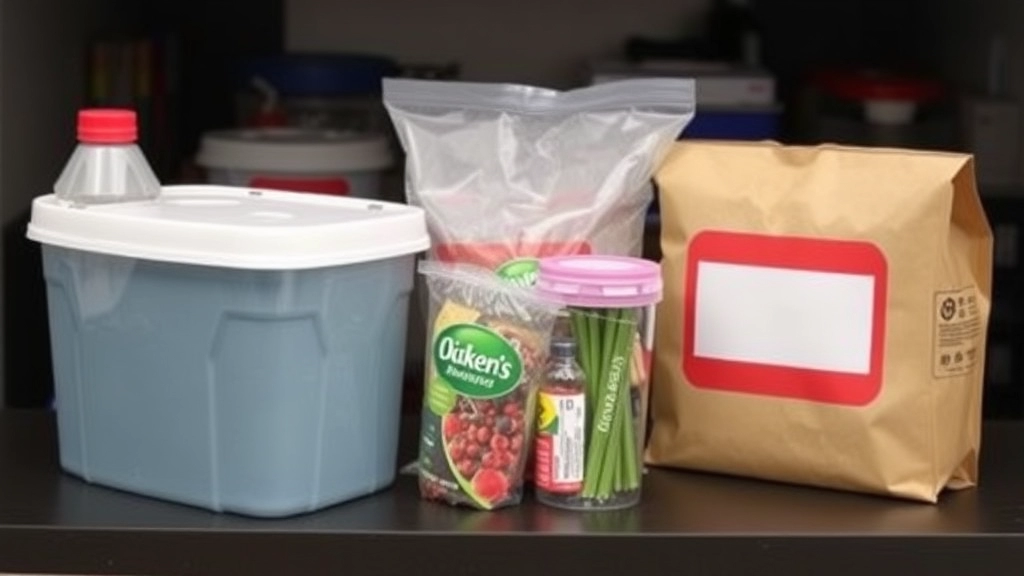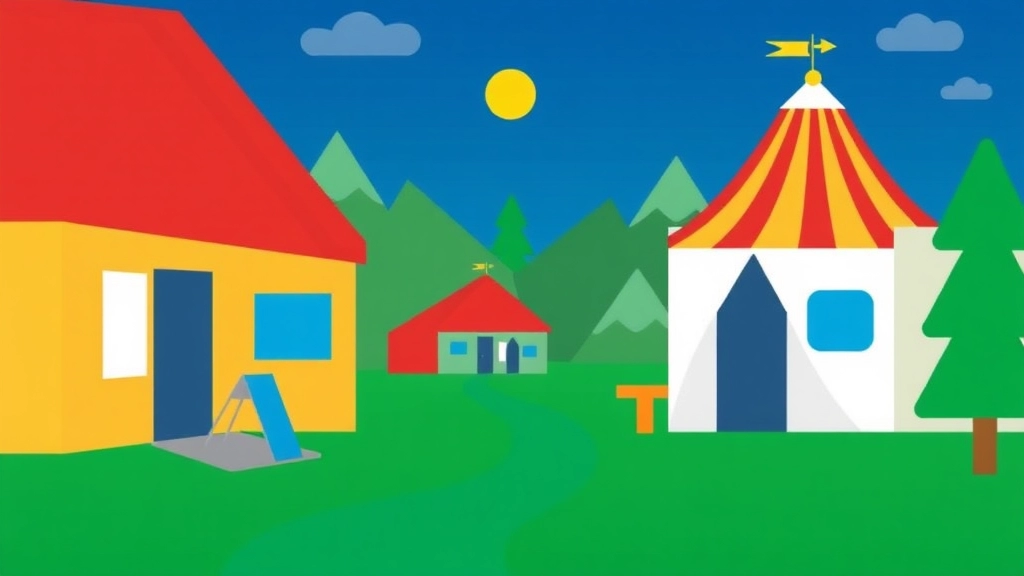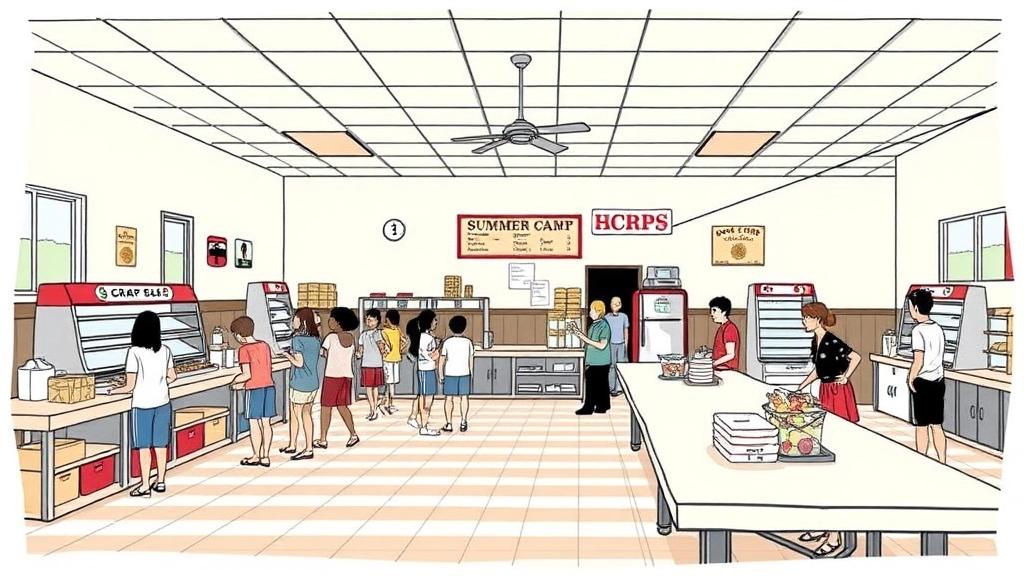Setting Up a Summer Camp Commissary
Setting up a summer camp commissary is no small feat, but it’s a rewarding venture that can significantly enhance the camp experience for both campers and staff. From selecting the right location and stocking essential supplies to managing inventory and setting competitive prices, every detail matters. This article will guide you through the process, offering practical tips and real-life examples to ensure your commissary becomes the heartbeat of your camp.
We’ll delve into creating a welcoming atmosphere, training staff for exceptional customer service, and adhering to health and safety regulations. Additionally, we’ll cover effective marketing strategies, handling payments smoothly, and evaluating your success through feedback. Whether you’re starting from scratch or looking to improve an existing setup, these insights will help you run a successful summer camp commissary that keeps everyone happy and well-supplied.
Setting Up a Summer Camp Commissary
Alright, so you’re thinking about setting up a summer camp commissary, huh? Let’s dive right in. I get it, the idea can be a bit overwhelming. Where do you start? What do you need? How do you make it run smoothly? Well, let’s break it down together.
Why Set Up a Summer Camp Commissary?
First off, why even bother with a commissary? Simple. It’s a lifeline for campers and staff. Imagine kids running around, burning energy, needing snacks, supplies, or even just a friendly face. Your commissary is the heartbeat of the camp, the go-to spot for everything they need.
Location, Location, Location
Choosing the right spot is crucial. You want it to be central and easy to access. Think about foot traffic. Where do campers naturally congregate? Near the dining hall? By the main lodge? That’s your sweet spot.
Design and Layout
Next up, the design. Keep it simple and functional. You don’t need a five-star setup, but you do need:
- Shelving: To keep things organised.
- Counter space: For transactions and displays.
- Storage: For backstock items.
Essential Equipment
Now, let’s talk gear. Here’s what you’ll need to get started:
- Cash register or POS system: For handling payments.
- Refrigeration units: For perishable items.
- Display cases: For snacks, drinks, and other goodies.
- Security measures: Like locks and cameras, to keep everything safe.
Stocking Up
What should you stock? Think essentials:
- Snacks and drinks: Kids love their crisps and sodas.
- Camp gear: Sunscreen, bug spray, water bottles.
- Merchandise: Camp T-shirts, hats, and souvenirs.
Real Talk: Challenges and Solutions
Setting up a commissary isn’t without its challenges. Here are a few common issues and how to tackle them:
- Limited space: Use vertical storage and keep only high-demand items on display.
- Budget constraints: Start small. Focus on must-haves and expand as you go.
- Staffing: Hire reliable, friendly staff. Training is key â more on that later.
Example: Camp Redwood’s Success Story
Let me share a quick story. At Camp Redwood, they started with a tiny shack and a few shelves. They focused on the basics and listened to camper feedback. Over the years, they expanded to a full-blown store, complete with a smoothie bar. The key? Start small, listen, and adapt.
For more tips on setting up your summer camp, check out our guide to setting up a successful canteen and our snack tips for summer camp commissaries.
Essential Supplies for Camp Commissaries

Alright, let’s dive in.
What do you need to stock up on for a camp commissary?
It’s a question every camp manager faces.
You want to make sure you’ve got everything campers need, right?
So, let’s break it down.
The Basics: Must-Haves
First off, snacks and drinks are non-negotiable.
Kids get hungry, and they’ll want something quick and tasty.
Think crisps, chocolate bars, and bottled water.
You might even throw in some healthier options like fruit snacks or granola bars.
Personal Care Items
Next up, personal care items.
Campers often forget essentials.
Stock up on toothpaste, toothbrushes, shampoo, and soap.
Trust me, someone will always need them.
Camp Gear
Now, let’s talk camp gear.
Extra batteries, torches, and insect repellent are lifesavers.
Don’t forget sunscreen and hats.
These can make or break a camper’s experience.
Fun Stuff
Of course, you can’t forget the fun stuff.
T-shirts, caps, and other branded merchandise are great.
Kids love souvenirs.
Emergency Supplies
Lastly, have some emergency supplies.
First aid kits, plasters, and antiseptic cream should be readily available.
You never know when you’ll need them.
Making It Easy
To make it easy for you, here’s a quick list:
- Snacks: crisps, chocolate bars, granola bars
- Drinks: bottled water, juice packs
- Personal care: toothpaste, toothbrushes, shampoo, soap
- Camp gear: batteries, torches, insect repellent, sunscreen, hats
- Fun stuff: T-shirts, caps, branded merchandise
- Emergency supplies: first aid kits, plasters, antiseptic cream
Real Talk
I remember one summer, we ran out of batteries.
Absolute chaos.
Kids were running around with dead torches.
Not fun.
So, stock up.
You’ll thank me later.
Managing Inventory and Stock Levels
Alright, let’s talk about managing inventory and stock levels for your summer camp commissary. You’re probably wondering, âHow do I make sure I don’t run out of marshmallows or sunscreen halfway through camp?â Trust me, I’ve been there. Managing inventory can feel like juggling flaming torches, but with the right strategies, it’s totally doable.
Why Inventory Management Matters
First off, why is this so important? Well, imagine kids coming in excited for their favourite snacks only to find empty shelves. Not a good look, right? Proper inventory management ensures you’ve got what you need when you need it, keeping campers happy and your camp running smoothly.
Inventory Tracking Systems
You can’t manage what you don’t track. Here’s where inventory tracking systems come in. Whether you’re using a fancy software or just a good old spreadsheet, make sure you’re tracking:
- Stock levels: Know what you have and what you need.
- Order history: Helps predict future needs.
- Supplier details: Quick reorders when stock runs low.
Setting Par Levels
Par levels are your best friend. These are the minimum amounts of each item you should have on hand. When stock dips below this level, it’s time to reorder. Here’s how to set them:
- Historical data: Look at past consumption patterns.
- Seasonal trends: More ice cream in the summer, more hot chocolate in the winter.
- Supplier lead time: How long does it take to restock?
Regular Audits and Stock Checks
Don’t just set it and forget it. Regular audits and stock checks are crucial. Schedule weekly or bi-weekly checks to:
- Verify stock levels: Make sure what’s on the shelf matches what’s in your system.
- Identify discrepancies: Catch theft or misplacement early.
- Update records: Keep your inventory data accurate.
Reordering Strategies
Reordering can be tricky. Order too much, and you’re stuck with excess stock. Order too little, and you’re out of essentials. Here’s a balanced approach:
- Just-in-time (JIT): Order just before you run out. Reduces storage costs but requires reliable suppliers.
- Bulk ordering: Great for non-perishables. Saves on costs but needs more storage space.
- Seasonal orders: Stock up on seasonal items in advance.
Real-Life Example
Let me share a quick story. One summer, we underestimated the demand for insect repellent. By week two, we were out, and campers were getting bitten left and right. Not fun. We quickly adjusted our par levels and made sure to have extra stock for the next season. Lesson learned!
Tools and Tech
Don’t shy away from using technology. Inventory management software can automate a lot of the grunt work. Look for features like:
- Automated reordering: Triggers orders when stock hits par levels.
- Real-time tracking: Keeps your data up-to-date.
- Supplier integration: Streamlines the ordering process.
For more tips on keeping your summer camp running smoothly, check out our summer camp commissary snacks tips and our summer camp starter pack guide.
Pricing Strategies for Camp Stores

Alright, let’s talk pricing strategies for camp stores.
You’ve set up your camp commissary, stocked it with essentials, and now you’re wondering, “How do I price this stuff?”
That’s a legit concern.
I’ve been there, scratching my head over how to balance making a profit without scaring off the campers.
Here’s the lowdown.
Know Your Audience
First off, who are you selling to?
Kids, teens, parents?
Each group has different spending habits.
Kids might blow their pocket money on sweets, while parents might be more interested in practical items.
Understanding this can help you set prices that make sense.
Competitive Pricing
Look around.
What are other camp stores charging?
You don’t want to be the most expensive shop in the woods, but you also don’t want to undersell yourself.
Find that sweet spot.
Cost-Plus Pricing
Here’s a straightforward method.
Take the cost of the item and add a markup.
Simple, right?
If a water bottle costs you £2, and you want a 50% markup, you sell it for £3.
Value-Based Pricing
Sometimes, it’s not about the cost, but the value.
A unique camp T-shirt or a limited-edition badge?
You can price these higher because they hold sentimental value.
Bundle Deals
Everyone loves a good deal.
Offer bundles like a snack pack or a hygiene kit.
It’s convenient for the campers and boosts your sales.
Seasonal Discounts
Got leftover stock?
Run a sale at the end of the camp season.
Better to sell at a lower price than not at all.
Monitor and Adjust
Keep an eye on what’s selling and what’s not.
If something’s flying off the shelves, you might be able to nudge the price up a bit.
If it’s gathering dust, consider a discount.
Real Example: The Snack Dilemma
Last summer, we had this situation with crisps.
We priced them too high initially, and they just sat there.
Dropped the price by 20p, and boom, they were gone in a week.
Lesson learned.
Creating a Welcoming Atmosphere at Your Camp Commissary
Ever walked into a camp store and felt like you’d rather be anywhere else? That’s exactly what we want to avoid. Creating a welcoming atmosphere is crucial. It’s not just about selling snacks and supplies; it’s about making campers feel at home. So, how do we do it?
Why Does Atmosphere Matter?
Let’s face it: a camp store that’s cold and uninviting is a place campers will avoid. We want them to come in, hang out, and maybe even buy something. A welcoming atmosphere boosts sales and keeps campers happy. So, what’s the secret sauce?
Key Elements of a Welcoming Atmosphere
1. Friendly Layout and Design
- Open Spaces: Keep aisles wide and clutter-free. Nobody likes bumping into shelves.
- Inviting Displays: Use bright colours and fun themes. Think summer vibes and campfire feels.
- Comfortable Seating: Add a few chairs or a cosy corner. Let them chill for a bit.
2. Engaging Decor
- Natural Elements: Use wood, plants, or even camp-themed decor.
- Lighting: Soft, warm lighting makes all the difference. Avoid harsh fluorescents.
- Signage: Clear, friendly signs guide campers to what they need.
3. Music and Ambience
- Background Tunes: Play some light music. Maybe a mix of summer hits or calming nature sounds.
- Scent: A subtle, pleasant scent can make the place feel more inviting.
Stories from the Field
I remember visiting a camp store where they had a small area with a campfire setup (fake, of course). Kids loved it! They’d sit around, chat, and even made new friends. It became a hangout spot, not just a store. That’s the kind of vibe we’re aiming for.
Staff Interaction
Your team is the face of the commissary. A friendly greeting goes a long way. Encourage staff to:
- Smile and Engage: A simple âHiâ can make someone’s day.
- Be Helpful: Know where everything is and offer assistance.
- Share Stories: A quick chat about the camp’s history or fun facts can create connections.
Creating a Community Feel
Think of your store as a mini-community hub. Host small events or activities:
- Craft Corners: Set up a spot for campers to make friendship bracelets.
- Game Nights: Have a board game or two available.
- Story Time: Organise a short story session in the evenings.
To further enhance the community feel, consider organizing some fun games that can bring everyone together. Additionally, offering a variety of snacks and tips can make the commissary a go-to spot for campers.
Staff Training and Customer Service

Ever wondered why some camp stores thrive while others flop?
It’s all about the staff training and customer service.
Why Staff Training Matters
Picture this: Kids running in, excited for their favourite snacks. Parents trying to get last-minute essentials. Chaos, right?
Without proper training, your staff will be overwhelmed.
Training is your secret weapon.
Key Areas to Focus On
- Product Knowledge
- Know what you’re selling.
- Understand the bestsellers and why they’re popular.
- Be ready to answer questions about products.
- Customer Interaction
- Smile. Always.
- Be patient, especially with kids.
- Handle complaints with grace. No one likes a grumpy store clerk.
- Sales Techniques
- Upselling without being pushy.
- Suggesting complementary products.
- Reading the customer’s mood and adjusting the pitch.
Real-Life Example
Remember that time when I was at a camp store, and the clerk knew exactly what I needed before I even asked?
That’s the power of good training.
Creating a Customer-Centric Culture
Your staff should be more than just employees.
They’re the face of your camp store.
Make them feel valued.
Tips for Effective Training
- Role-playing: Simulate real-life scenarios.
- Regular feedback: Praise what’s working, correct what’s not.
- Incentives: Reward great customer service.
Customer Service: The Heartbeat of Your Store
Good customer service isn’t just about being nice.
It’s about creating an experience.
Happy customers = Repeat customers.
Handling Difficult Situations
It’s not always sunshine and rainbows.
Sometimes, you’ll face tough customers.
Stay calm.
Listen actively.
Resolve issues quickly.
Health and Safety Regulations
Alright, let’s talk about health and safety regulations for your summer camp commissary. I know, it might not be the most thrilling topic, but trust me, it’s crucial. You don’t want to be that camp that gets shut down because you overlooked a few key rules. So, how do you keep everything above board and ensure everyone’s safe and sound?
Why Health and Safety Matter
First off, think about the parents. They’re trusting you with their kids. The last thing they want to hear is that their kid got sick because you didn’t follow some basic health guidelines. Plus, staying compliant with health and safety regulations isn’t just about avoiding finesâit’s about building trust and credibility.
Key Health and Safety Regulations to Follow
Here are the essentials you need to cover:
- Food Safety: This is a big one. Make sure all your food is stored at the right temperatures. Cold foods should be kept below 5°C, and hot foods should be above 63°C. And yes, you’ll need a thermometer to check this.
- Cleanliness: Your commissary should be spotless. That means regular cleaning schedules, proper waste disposal, and making sure all surfaces are sanitised. Trust me, a clean space is a safe space.
- Pest Control: Nothing says “unprofessional” like a rodent or insect problem. Regularly inspect your commissary for any signs of pests and have a plan in place for dealing with them.
- Staff Hygiene: Your staff should be trained in basic hygiene practices. This includes washing hands regularly, wearing clean uniforms, and using gloves when handling food.
Training and Certification
Get your team certified. Many local councils offer food safety courses that are quick and affordable. It’s a small investment that can save you a lot of headaches down the line.
- First Aid Training: It’s not just about food. Ensure at least one person on each shift is trained in first aid. Accidents happen, and being prepared is key.
- Fire Safety: Equip your commissary with fire extinguishers and make sure everyone knows how to use them. Regular fire drills can also be a lifesaver.
Regular Inspections
Don’t wait for the health inspector to show up. Conduct your own regular inspections to catch any issues before they become problems. This proactive approach can save you a lot of trouble.
Real Talk: Stories from the Field
Let me share a quick story. A buddy of mine runs a camp commissary and once had a minor outbreak of food poisoning. It turned out one of the fridges wasn’t keeping food cold enough. It was a nightmareâparents were furious, and he had to shut down for a week. Since then, he’s religious about checking temperatures and training his staff. Lesson learned.
Marketing and Promotions for Camp Stores

Ever wondered how to get more campers flocking to your camp store?
Marketing and promotions are key.
Let’s break it down.
Why Marketing Matters
You can have the best camp store, but if no one knows about it, what’s the point?
Marketing makes sure everyone knows what you’ve got.
Start With These Questions
- How do I get campers excited about my store?
- What’s the best way to spread the word?
- How can I make promotions fun and effective?
Social Media: Your Best Friend
First things first, social media.
- Instagram and Facebook: Post pictures of new stock, special offers, and events.
- Stories and Reels: Quick, engaging content that shows off your store.
- Hashtags: Use camp-related hashtags to reach a wider audience.
Email Newsletters: Keep Them in the Loop
Don’t underestimate the power of a good email newsletter.
- Weekly Updates: Share new arrivals, special deals, and upcoming events.
- Exclusive Offers: Give your email subscribers first dibs on sales.
Word of Mouth: Old School but Gold
Never forget the power of word of mouth.
- Referral Programs: Offer discounts or freebies for campers who bring friends.
- Camp Announcements: Make sure camp leaders mention the store during gatherings.
Promotions That Pop
Now, let’s talk promotions.
- Flash Sales: Limited-time offers that create urgency.
- Bundle Deals: Package items together at a discount.
- Loyalty Programs: Reward repeat customers with points or discounts.
Real-Life Example
Last summer, we ran a “Buy One, Get One Free” on ice creams during the hottest week.
Guess what?
We sold out in two days.
Creating Buzz with Events
Host events to draw in the crowd.
- Themed Nights: Like “80s Night” where everything is retro-themed.
- Competitions: Scavenger hunts that lead to your store.
Feedback Loop
Finally, always ask for feedback.
- What promotions did they love?
- What didn’t work?
This helps you tweak and improve your strategies.
Handling Payments and Transactions
Ever wondered how to make handling payments at a summer camp commissary as smooth as a summer breeze? Yeah, me too. Let’s dive into the nitty-gritty of it.
What’s the Big Deal with Payments?
First off, payments aren’t just about exchanging cash. They’re about making things easy for campers and staff. You want it quick, secure, and hassle-free. No one likes standing in line, right?
Options for Payment Methods
So, what’s the best way to handle this? Here’s a breakdown:
- Cash: Old school but reliable. Just make sure you have enough change.
- Credit/Debit Cards: Super convenient. Invest in a card reader.
- Mobile Payments: Apple Pay, Google Wallet â the cool kids use these.
- Camp Account: Let campers pre-load an account for a cashless experience.
Setting Up for Success
Now, let’s talk setup. You need a solid system:
- Choose a Point of Sale (POS) System: Pick one that’s user-friendly and fits your budget.
- Secure Internet Connection: No internet, no card payments. Simple as that.
- Backup Plan: What if the power goes out? Have a manual process ready.
Training Your Team
Your staff needs to be on point with handling transactions:
- Train them on using the POS system.
- Teach them about security â no one wants a data breach.
- Prepare them for common issues like card declines.
Keeping it Safe and Sound
Security is huge. Here’s how you keep it tight:
- Encrypt Data: Make sure all transactions are secure.
- Regular Audits: Check your systems for any vulnerabilities.
- Secure Cash Storage: Lock it up and limit access.
Making it Easy for Campers
Remember, it’s all about the campers:
- Clear Signage: Let them know what payment methods you accept.
- Fast Transactions: Keep the line moving.
- Friendly Service: A smile goes a long way.
Real Talk: Stories from the Field
I once heard about a camp that switched to mobile payments and saw transactions speed up by 50%. Campers loved it, and staff had fewer headaches. Win-win.
Evaluating Your Payment System
Finally, keep an eye on how things are going:
- Track Transactions: See what’s working and what’s not.
- Ask for Feedback: Campers and staff will tell you what’s up.
- Adjust as Needed: Don’t be afraid to tweak the system.
Handling payments and transactions doesn’t have to be a nightmare. With the right setup and a bit of training, you’ll have a system that’s as smooth as your morning coffee. Keep it simple, keep it secure, and keep it camper-friendly.
For more tips on setting up your summer camp, check out our guide on summer camp canteen setup. And if you’re looking for advice on creating a welcoming environment, our article on summer camp commissary snacks has you covered.
Evaluating Success and Gathering Feedback
Ever wondered if your summer camp commissary is hitting the mark?
Well, you’re not alone.
Let’s dive into how you can evaluate success and gather feedback without the fluff.
Why Bother with Evaluation?
First off, knowing if your camp store is doing well is crucial.
You want to make sure your efforts are paying off.
And if not, you need to know what to tweak.
Key Metrics to Track
Here’s what you should be looking at:
- Sales Data: Are you selling out of certain items? Or are some just gathering dust?
- Customer Satisfaction: Are campers and staff happy with what you offer?
- Inventory Turnover: How quickly are items moving off the shelves?
Gathering Feedback
You can’t improve what you don’t measure, right?
Here’s how to get the intel you need:
- Surveys: Hand out quick surveys to campers and staff. Keep it short and sweet.
- Suggestion Box: Old school, but it works. Place it in a visible spot.
- Face-to-Face: Sometimes, the best feedback comes from a casual chat.
Real Stories, Real Feedback
I remember one camp where we thought our snack selection was top-notch.
Turns out, the kids wanted healthier options.
We only found out because we asked.
Analysing the Data
Once you’ve got the feedback, it’s time to dig in.
Look for patterns.
Are multiple people asking for the same thing?
That’s your cue.
Making Adjustments
Don’t sit on the feedback.
Act on it.
- Restock Popular Items: If something’s flying off the shelves, get more.
- Ditch the Duds: If it’s not selling, replace it.
- Improve Customer Service: Train staff based on feedback.
Keeping It Ongoing
Evaluation isn’t a one-time thing.
Make it a habit.
Set up regular check-ins, maybe once a month, to see how things are going.
For more tips on creating a successful camp environment, check out our guide on summer camp culture, traditions, and activities.
FAQs on Summer Camp Commissary
What are the essential supplies for a camp commissary?
Essential supplies include snacks and drinks like crisps, chocolate bars, and bottled water. Don’t forget personal care items such as toothpaste, toothbrushes, shampoo, and soap. Camp gear like batteries, torches, and insect repellent, as well as fun items like T-shirts and caps, are also important. Emergency supplies such as first aid kits should be readily available.
How should I price items in my camp store?
Consider your audience when setting prices. Use competitive pricing by looking at what other camp stores charge. Cost-plus pricing is straightforward—add a markup to the cost of the item. Value-based pricing works for unique items. Bundle deals and seasonal discounts can also be effective strategies.
Why is staff training important in a camp store?
Staff training ensures your team can handle the busy environment of a camp store. Focus on product knowledge, customer interaction, and sales techniques. Well-trained staff can significantly improve customer satisfaction and store efficiency.
What are some effective marketing strategies for a camp store?
Utilize social media platforms like Instagram and Facebook to showcase new stock and special offers. Email newsletters can keep your audience informed about updates and exclusive deals. Word of mouth remains powerful, so consider referral programs and camp announcements. Promotions like flash sales, bundle deals, and loyalty programs can also drive traffic to your store.
What should I include in emergency supplies for a camp store?
Emergency supplies should include first aid kits, plasters, and antiseptic cream. These items are crucial for addressing minor injuries and ensuring camper safety.
How can I make my camp store more appealing to campers?
Stock a variety of fun and practical items. Branded merchandise like T-shirts and caps are popular. Hosting events, offering promotions, and creating a welcoming atmosphere can also make your store more appealing.
What are some tips for handling difficult customers in a camp store?
Stay calm, listen actively, and resolve issues quickly. Good customer service involves creating a positive experience, even in challenging situations. Training your staff to handle complaints gracefully is essential.
How can I ensure my camp store remains profitable?
Monitor and adjust prices based on sales trends. If an item is selling quickly, consider a slight price increase. For items that aren’t moving, offer discounts. Regularly review your pricing strategy to maintain a balance between profitability and customer satisfaction.
References
-
Summer Camp Essentials Packing List
-
Camping Checklist: Everything You Need for a Successful Trip
-
Family Camping Checklist

